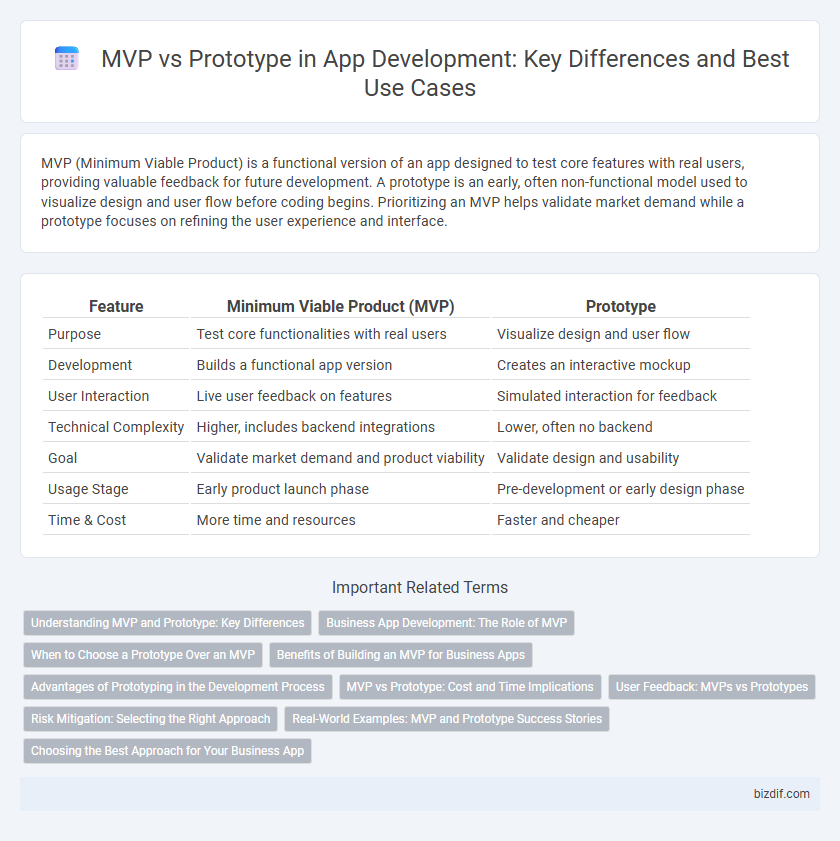MVP (Minimum Viable Product) is a functional version of an app designed to test core features with real users, providing valuable feedback for future development. A prototype is an early, often non-functional model used to visualize design and user flow before coding begins. Prioritizing an MVP helps validate market demand while a prototype focuses on refining the user experience and interface.
Table of Comparison
| Feature | Minimum Viable Product (MVP) | Prototype |
|---|---|---|
| Purpose | Test core functionalities with real users | Visualize design and user flow |
| Development | Builds a functional app version | Creates an interactive mockup |
| User Interaction | Live user feedback on features | Simulated interaction for feedback |
| Technical Complexity | Higher, includes backend integrations | Lower, often no backend |
| Goal | Validate market demand and product viability | Validate design and usability |
| Usage Stage | Early product launch phase | Pre-development or early design phase |
| Time & Cost | More time and resources | Faster and cheaper |
Understanding MVP and Prototype: Key Differences
An MVP (Minimum Viable Product) is a functional version of an app designed to deliver core features to early users and gather real-world feedback, enabling iterative development and market validation. In contrast, a prototype is an early, often non-functional model used mainly to visualize design concepts, user flows, and interface elements before any coding begins. Understanding these distinctions helps teams allocate resources efficiently, prioritize user testing, and accelerate product-market fit.
Business App Development: The Role of MVP
In business app development, an MVP (Minimum Viable Product) serves as a functional version of the software with core features designed to solve specific user problems and validate market demand, enabling rapid feedback and iterative improvements. Unlike a prototype, which is often a non-functional model used primarily for design validation and early concept testing, an MVP provides real user interaction and measurable data to guide development priorities. Leveraging an MVP minimizes investment risk and accelerates time-to-market by focusing on essential functionalities that demonstrate value to stakeholders and end-users.
When to Choose a Prototype Over an MVP
Choosing a prototype over an MVP is ideal during the early stages of app development when validating user experience and design concepts is critical. Prototypes allow for rapid iteration and feedback gathering without the full technical build, making them cost-effective for testing functionality and layout. When product-market fit and core features remain unclear, prototypes provide a flexible environment to explore ideas before committing resources to MVP development.
Benefits of Building an MVP for Business Apps
Building an MVP for business apps enables faster market entry by focusing on core functionalities that address user needs, reducing development costs and minimizing risks compared to full-scale product launches. It facilitates early user feedback, allowing iterative improvements and validation of business hypotheses before significant investment. By demonstrating value quickly, an MVP can attract stakeholders and secure funding essential for subsequent development stages.
Advantages of Prototyping in the Development Process
Prototyping accelerates feedback collection by presenting a tangible model that stakeholders can interact with, reducing misunderstandings and costly revisions. It enhances user experience design through iterative testing, enabling developers to identify usability issues early in the development cycle. Prototypes also facilitate clearer communication among team members and investors, improving alignment on project goals and features.
MVP vs Prototype: Cost and Time Implications
Developing a Minimum Viable Product (MVP) typically requires more time and financial investment than creating a prototype, as an MVP aims to deliver a functional product with core features for early users. Prototypes are generally quicker and cheaper to build, serving as preliminary models to validate ideas and design concepts without full functionality. Investing in an MVP accelerates market entry and user feedback collection, while prototypes help minimize upfront costs by refining requirements before full development.
User Feedback: MVPs vs Prototypes
MVPs (Minimum Viable Products) provide users with a functional version of the app, enabling real-world user feedback on core features and usability, which is invaluable for guiding iterative development. Prototypes primarily serve as visual models or simulations, gathering early-stage feedback on design, flow, and concept rather than full functionality. User feedback from MVPs typically leads to data-driven decisions based on actual use, whereas prototypes inform design adjustments through exploratory insights.
Risk Mitigation: Selecting the Right Approach
Choosing between an MVP and a prototype significantly impacts risk mitigation in app development by aligning project goals with resource allocation. Prototypes serve as low-cost, early-stage models to validate design concepts and user flows, reducing the risk of fundamental usability errors. MVPs deliver a functional product with core features, enabling real-world market testing and feedback collection, which minimizes the risk of feature misalignment and market rejection.
Real-World Examples: MVP and Prototype Success Stories
Spotify's MVP focused on core music streaming features, quickly gaining users and attracting investors by solving a real pain point in the market. Airbnb's prototype initially tested basic room rental concepts, enabling early validation and iterative improvements before scaling to a full MVP with payment processing and user reviews. These real-world examples illustrate how MVPs prioritize market-ready functionality, while prototypes emphasize hypothesis testing and user feedback.
Choosing the Best Approach for Your Business App
Selecting between an MVP and a prototype hinges on your business app's goals: an MVP delivers a functional product with core features for early user feedback and market validation, while a prototype offers a visual or interactive model to refine design and user experience before development. For startups aiming to test market viability quickly and secure early adopters, an MVP provides actionable insights and real-world data to guide iterations. Businesses prioritizing user interface design and stakeholder alignment benefit from prototyping to minimize risks and clarify requirements prior to full-scale development.
MVP vs Prototype Infographic

 bizdif.com
bizdif.com